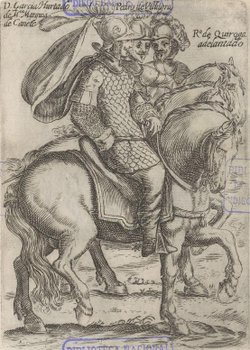Pedro de Villagra facts for kids
Quick facts for kids
Pedro de Villagra
|
|
|---|---|

From left to right: García Hurtado de Mendoza, Pedro de Villagra and Rodrigo de Quiroga in an illustration by Alonso de Ovalle
|
|
| Royal Governor of Chile | |
| In office 1563–1565 |
|
| Monarch | Philip II |
| Preceded by | Francisco de Villagra |
| Succeeded by | Rodrigo de Quiroga |
| Personal details | |
| Born | 1513 Mombeltrán, Ávila, Spain |
| Died | 11 September 1577 Lima, Peru |
| Military service | |
| Allegiance | |
| Years of service | 1530s–1565 |
| Battles/wars | Conquest of Chile |
Pedro de Villagra y Martínez was a Spanish soldier born in 1513. He played a big part in the Spanish conquest of Chile. He even became the Royal Governor of Chile from 1563 to 1565. He passed away in 1577 in Lima.
Contents
Pedro's Early Life and Journey to Chile
Pedro's father was Juan de Villagra. In 1537, Pedro left Spain. He traveled to places like Cartagena de Indias and Santa Marta before reaching Peru. Later, he joined the expedition of Pedro de Valdivia to Chile.
Life in Santiago and First Return to Peru
When the city of Santiago was founded, Villagra served as its mayor for four years. He also received land in Tirúa from Valdivia. After Governor Valdivia died, Pedro moved back to Peru. There, he married Beatriz de Figueroa.
Fighting in the Arauco War
Pedro de Villagra returned to Chile when his relative, Francisco de Villagra, became governor. Pedro fought in the Arauco War, a long conflict against the Mapuche people. When Governor Francisco de Villagra became ill, Pedro took charge of the Spanish forces in the south.
In 1556, he led the soldiers who pushed back Lautaro, a Mapuche leader, from Santiago. This happened during the Battle of Peteroa.
Becoming Governor of Chile
Pedro again commanded forces under Francisco de Villagra when he became governor for a second time in 1561. On June 22, 1563, Francisco de Villagra died. He named Pedro de Villagra as the temporary governor. The Viceroy of Peru, Diego López de Zúñiga y Velasco, later confirmed this appointment.
As governor, Pedro changed his military plan. He decided to bring his soldiers closer together. He moved troops from the fort at Arauco to make Angol and Concepción stronger.
Important Battles and Victories
The Mapuche people suffered some big losses when they attacked Angol. The Spanish soldiers there, led by Lorenzo Bernal del Mercado, caused over a thousand casualties. They also killed the Mapuche leader, or toqui, Illangulién, in the Battle of Angol.
After this, Pedro de Villagra led a new campaign in the south. He helped the city of Concepción during the Siege of Concepcion. His forces won important battles at Reinohuelen and Tolmillán. These battles took place against the Mapuche north of the Bio-Bio River. These victories led to a few years of peace between the Spanish and the Mapuche.
End of His Governorship
In 1564, the viceroy López de Zúñiga y Velasco died. This made things difficult for Villagra. In 1565, the new viceroy, Lope García de Castro, ordered Pedro to be replaced. Rodrigo de Quiroga took over as governor. Pedro was arrested and sent to Peru.
In Peru, Pedro de Villagra was able to prove his innocence. After being cleared, he asked the king for payment for his services. However, he never received a reply. He died in Lima on September 11, 1577.
See also
 In Spanish: Pedro de Villagra para niños
In Spanish: Pedro de Villagra para niños

